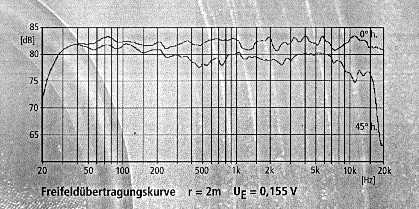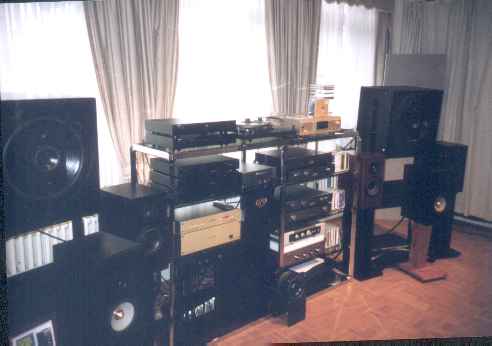![[ME Geithain RL-901]](../gif/rl901.jpg)
![[ME Geithain RL-901]](../gif/rl901.jpg)
Product: Studio Reference Monitor Loudspeaker RL-901
Manufacturer:
Musikelectronic Geithain, Nikolaistrasse 7, D-04643 Geithain, fax
+49.(03.43.41)3.11.44
Approximate price: e12500 / US$14700 (pair)
Test sample: auditioned at local distributor's
The fall of the Berlin Wall has brought us, audio-wise, two good things from East-Germany. One of these you know already, our resident cable-loonie Thorsten Loesch; the other you're about to be acquainted with now.
Enter Musikelectronic Geithain, a small (13 employees) loudspeaker manufacturer, situated in the picturesque village of ... Geithain, and deep into quality professional audio since, oh, the sixties. Not just pro-audio. No. Uncompromised pro-audio. Headed by Joachim Kiesler, musician, director, and instrument-builder, not to mention engineer, Geithain made its quest the quest for perfect neutrality. And for perfect dynamics.
And so, after a small-scale start, the company grew. And its speakers grew, in size and in ambition. Implementing improvement after improvement. And the factory grew, now including a large anechoic room as well as a rather unique reference room for multi-channel reproduction.
These people do not know the verb 'to compromise'. Safely tucked-away in behind the Iron Curtain, these people simply tackled any problem encountered by investigating it, and then by bluntly eliminating it.
As you already would have thought by now: ME Geithain make all of their components in-house, according to their own ideas, and rooted in their own decades-old experience. Perhaps that a few years isolation from the western world is not a bad thing in hifi!
Or is it? Other things indicate that ME-Geithain also has remained wrapped-up in professional audio lore, and hence that they have not been receptive to some of the valid new findings originating from the audiophile community. Perhaps the future can bring a bit of cross-fertilisation?
The RL-901 is Geithain's biggest model except one, being a massive and forbidden-looking black cube of 55 x 50 x 43 cm, weighing in at a mean 48 kg - each - and housing a full three-way system based on a 40 cm woofer in a closed box, 12 cm inverted-dome midrange and a dome tweeter. All of this manufacturer's loudspeakers are active models, this particular one relying on one 180W and two 100W (ref. 4 Ohms) class AB amps and associated crossovers working at 550Hz and at 2.8kHz. The line input feed is balanced only, and the RL-901s feature no adjustable settings for tonal balance: this model is the reference model, to be used in large, acoustically-treated locations such as classical music studios, rooms which have to be optimised for the speakers, rather than the other way around. But do note that Geithain's smaller models, all active as well, feature adjustable settings for bass and treble balance.

The other salient point is that these are quasi-coaxial loudspeakers: midrange and tweeter sit on a small metal baffle which is suspended in front of the bass cone. This baffle is so wide that it makes it impossible for the tweeter to 'see' the woofer, at once a solution to a basic problem of most other coaxials. The midrange cone is not loaded by a box, but rather its rear output is dissipated in a pack of absorbent mounted right behind it. Time-alignment of the mid and top drivers relative to the bass driver is done in the active crossover circuitry. This gives the speaker a coherent phase behaviour over most of the spectrum. By the way, talking about spectra, the anechoic response of the RL-901 is flat within 5dB from 25Hz to 20kHz. And better, even its 45 degree horizontal off-axis response still is commendably flat. Which all together makes us expect something extra-ordinary when it comes to imaging, not?
But what about the RL-901s own 'image'? Well, suffice to say that they are ugly. Very ugly. Though of course the manufacturer would point out that they were not made to look at anyway, so what the heck are we nagging about? (We are nagging about marketability...)
With my eyes wide shut I auditioned these speakers in a highly curious system comprising Sony XA-50ES CD transport, the mighty LFD DAC-3 (did you know it was LFD who made analogue doyen SME's digital-to-analogue converter, a classy component that never saw commercial life?), the just-as-migthy LFD balanced passive preamp with its switched-resistor attenuators, long runs of some non-descript interconnect cable, and then the RL-901s with their low 10kOhms input impedance. Such systems ought not to work, but then again, in quality audio the only hard rule is that there are no hard rules, and the local distributor swears with the LFD pre for 'the taming influence it brings to the speakers undomesticated bass'.

The black boxes were positioned 1.5m from ground level in their matching studio frames, perhaps 4 m wide, and well enough from any walls. The room featured RPG Acoustics bass traps throughout: a necessity in what is otherwise a troublesome place.
Normally I don't really like big loudspeakers. Exceptions to this rule are Jamo's Oriels, big ATCs, and the Apogees of yore, but in general things like Wilsons and giant Acapellas are not quite my cup of thea. This just as an intro to me having to say that I found the RL-901s remarkably easy to listen to: they sound dynamically explosive, very 'real', with a loose subterranean bass and lots of tiny details everywhere, but they're also quite natural and indeed lack the edge and sizzle normally associated with studio-class monitoring speakers.
Starting with Cassandra Wilson's New Moon Daughter, we got a full-bodied overall presentation, with raspy trumpet to the left decaying into the far-away, at the same time the double-bass, drum and guitar breaking loose to the far right. Trumpet and rhythm section clearly playing together, but not unduly influencing each other. Oh, and in the middle Cassandra standing. Of course.
In the mid-bass a slight booming or oooh-sound manifested itself, which was kind of strange and unexpected initially, given Geithain's obsession with neutrality. After some consideration we concluded this had to be a room anomaly: the floor was largely undamped, so a direct reflection of the woofer's sound and resulting interference at the listening position, situated at around 170Hz or so, could well have done this: the high Geithain stands may be suited to near-field studio monitoring, for long-range listening in a living room they are less than ideal, not to mention that they are in fact also less than rigid... (Oh, and more than ugly !-)
Going over to the Dead Can Dance disc, the audience was protrayed realistically. The bells starting track one loud, penetrant, cristalline. In the good sense of the words. Further there was no grain, no aggression, again that ooh-sound in the bass, but also a very wide and rather deep soundstage, with decent rhythmical behaviour throughout.
Monteverdi was rendered in a very colourful way, with rasping brass, playful flutes, and full-bodied voices.
Mary Black sounded open, with in the track Columbus that one lone cymbal far to the right finely differentiated. With many other speakers or systems this particular cymbal sounds just like a grey tizzzz. The strings at the end of the song were really resin-like, the RL-901 giving here a performance as good as I remember it from the wonderful Apogee Caliper Signature ribbon speakers.
Staying with a cello, Yo-Yo Ma's sounded warm, grumbling, gracious. Probably like Bach intended it, which is not a bad thing.
And then the Walkabouts delivered a deep and full bass (less dry than the B&W Nautilus 801s), with good voices (though there was a little bit of friction on sibilants), fingers touching guitar strings and fretboards. Open, wide, layered, with the strings being an entity on their own, playing with the rock band, coherently.
And the Loreena McKennitt disc, which sounded so awfully thin on the B&Ws, now did much better again, with indeed pretty good vocals!
A brief spell with an active preamp from JDI gave an even more dynamic (read: thunderous) sound, with explicit bass and treble, but overall I found the LFD-sourced music more natural.
If fatigue could set in after a few hours of listening, then it was not due to any inherent problems with these speakers, but rather because of the listening levels which were higher than what I am used to. The Geithains simply invite you to crank the volume!
![[ME Geithain RL-904]](../gif/rl904.jpg)
Later on I also had the chance to audition the much smaller RL-904s. These are an active pseudo-coaxial two-way design, not larger than your average stand mounter, but still with an anechoic response that is commendably flat between 40Hz and 20kHz, and each with two 100W amplifiers built in. In the midrange and treble they sounded similar to their much bigger brothers, only a little bit thinner, less open, but just as controlled and dynamic. It was amazing what kind of bass came out of their tiny 12 cm woofers: obviously a result of their active equalization and drive which gives good extension, but at the same time, and perhaps expectedly so, the bass also could sound a bit processed and opaque. Clearly, these speakers, at their price of e5000, are a viable solution when one demands neutral, powerful and dynamic speakers which at the same time must be small. For audiophile types, though, the same kind of money buys more balanced and musical speakers. Which then are bound to be more than a bit taller, of course.
These Geithains excel in every parameter one seeks in huge speakers: extension, neutrality, dynamics, grandeur of sound. Futhermore, we have here a loudspeaker system that, while perhaps not so extremely detailed, still in many respects, and especially in sheer listenability, surpasses the also-big B&W 801 / Krell combination I tested earlier (but please note that such statements are very system-dependent, and prospective buyers always should listen for themselves), and this at less than one third of the package price: surely something to be applauded.
Now if only the manufacturer could bring us the same sound in a less aesthetically challenged package ...
© Copyright 1999 Werner Ogiers - http://www.tnt-audio.com